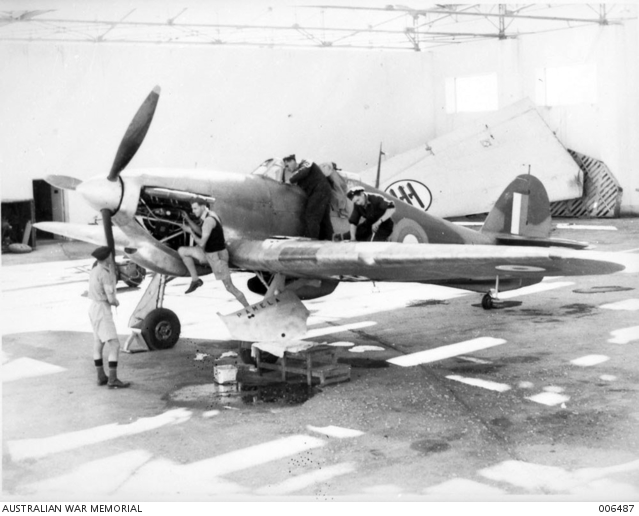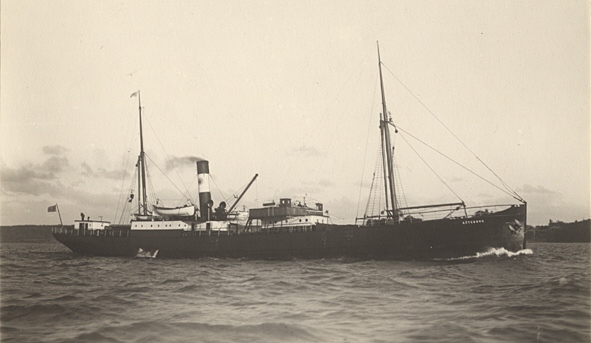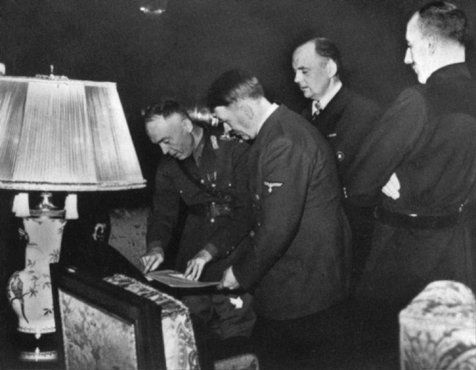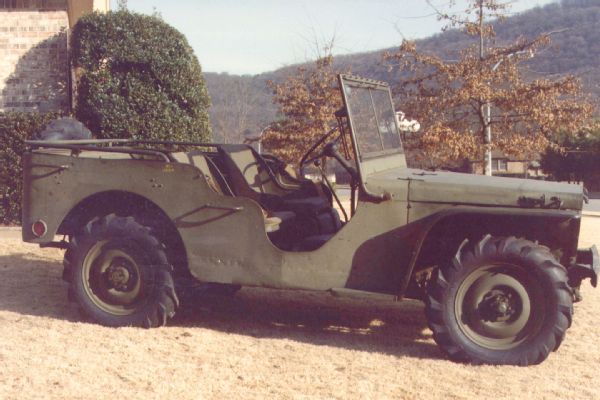Italian/Greek Campaign: Limited Greek offensive operations continue on 7 March 1941 at the center of the line, west of Klisura Pass in the Senteli Mountains, by II Corps (1st, 5th, 11th, 15th, and 17th Divisions). The Italians are building up their forces for a major effort in the same effort, so the Greeks make little progress.
South African leader Jan Smuts is in Cairo consulting with British Middle East Commander General Archibald Wavell, Foreign Minister Anthony Eden and CIGS John Dill. He okays the use of his country's troops wherever they are needed, which at the moment is Greece. Smuts sends a telegram to Whitehall expressing his agreement to the use of South African troops there.
The flow of British troops from Suda Bay, Crete and Alexandria to Piraeus (Athens) continues. Today, cruisers HMS Bonaventure, Gloucester and York arrive and disembark the troops they are carrying. Slower freighters also arrive carrying their equipment. These troops for Operation Lustre include parts of the British 1st Armoured Division.
New Zealand General Bernard Freyberg arrives in Athens. He is slated to command a major part of the British force.
East African Campaign: The British continue advancing toward Mogadishu along the main road in Italian Somaliland. Supply difficulties are slowing them more than scattered Italian opposition.
European Air Operations: The Luftwaffe continues its lone-raider operations during the day, dropping scattered bombs hither and thither. The British claim to down two bombers, one by convoy escort HMS Guillemot. RAF Coastal Command attacks Den Helder and shipping off the Dutch coast. RAF Bomber Command is inactive.
Battle of the Atlantic: It is an extremely busy day in the Battle of the Atlantic. However, one event stands out above all the others.
Günther Prien is one of the top U-boat aces, having received news of his promotion to Korvettenkapitän as of 1 March 1941 (though technically he remains a Kapitänleutnant at this time, the promotion becoming effective posthumously). Prien has to date been mentioned in the official military communiques (Wehrmachtbericht) seven times (with another to come). Each mention on the nightly news is one of the highest honors of the Third Reich, equivalent to receiving a top medal.
Prien also became the 5th recipient of the Oak Leaves to the Knight's Cross of the Iron Cross as Kapitänleutnant and commander of U-47 (on 20 October 1940). Throughout his career (including today), Prien has sunk 30 merchantmen of 162,769 tons, sunk a warship of 29,150 tons (Royal Navy battleship HMS Royal Oak at Scapa Flow in 1939), and damaged eight other merchantmen of 62,751 tons along with a warship of 10,035 tons. Günther Prien is a commander of great daring and an asset to the U-boat command.
Today, Prien sights Convoy OB-293 and vectors in a Wolf Pack (the other U-boats involved are U-70, U-99, and U-A). Prien's U-47 damages 20,638-ton British whaling factory ship Terje Viken (reputedly the world's largest before the war, currently serving as a tanker). U-70 (Kptlt. Joachim Matz) also fires three torpedoes at it, but misses. Before U-70 can fire a fourth, U-99 (Otto Kretschmer) then torpedoes and disables the Terje Viken, turning it into a flaming wreck. The whaling ship's crew abandons ship and survives. The abandoned derelict remains afloat for a while, but finally is sunk by the Royal Navy escorts as a hazard to navigation.
Afterward, U-47 disappears. Since none of the 45 men on board ever is heard from again, it is unknown what happened to U-47. One theory is that U-47 is destroyed or seriously damaged by attacks from convoy escorts HMS Wolverine and Verity, two of four destroyers in the vicinity. In any event, the warships do see what is believed to be the U-boat rise almost to the surface, then explode in an orange fireball. However, recent scholarship has called the identity of this U-boat into question, and it may not have been U-47 at all that the British saw explode. In fact, some wild conspiracy theories posit that Prien survived the patrol, but was arrested for subversion upon his return to port - but that has been completely disproven (among other things, Prien was a solid member of the NSDAP, but there are many other reasons this theory is not widely believed).
Of all the U-boat commanders, it is fair to say that Prien's memory has been the most long-lasting within the German military. His name has been considered for several major weapons systems, and his life has been celebrated in various media forms such as film and books. His death also is the first of three top U-boat commanders in the next ten days which are extremely damaging to the fleet and show how thin the "bench" of ace commanders is. This lack of depth is an endemic problem within all branches of the German military, as top Luftwaffe aces and tank commanders also are extremely difficult to replace when lost.
The German authorities soon realize that U-47 is missing and presumed lost. However, the Propaganda Ministry decides to keep the news from the public. The British also realize that Prien is missing - they have excellent spies - and turn Prien's loss and the German decision to keep it hidden into a propaganda coup. The RAF will drop leaflets over Germany asking "Wo ist Prien?" (Where is Prien), stirring wild speculation about his fate throughout the Reich.
The other U-boats in the Wolf Pack also make attacks and suffer as well. U-70, on its first patrol, has a big day, and not in a particularly good way. First, at 04:30, it torpedoes and sinks 6570-ton British tanker Athelbeach. Seven crew perish So far, so good for U-70 (Some sources assign this sinking to U-99, but the U-70 crew claimed credit as set forth in its interrogation report).
Then, at 04:50, U-70 torpedoes 6423-ton British freighter Delilian. The crew abandons ship, but later returns and manages to restart the engines and make port.
U-70 then, at 06:25, torpedoes 7493-ton Dutch tanker Mijdrecht. The Mijdrecht has made the "mistake" of stopping to pick up survivors of the Delilian, but the ship remains maneuverable. The captain of the Delilian spots the U-boat's periscope and reacts immediately. He turns the ship and rams U-70. This causes the U-boat to surface, and the Mijdrecht uses one of its guns to hit U-70's conning tower (the U-boat's crew denies this, but it is a minor point). U-70's crew then abandons ship, and U-70 sinks. Mijdrecht, meanwhile, manages to make port, a rare instance when a merchant ship sinks a U-boat and survives rather than the other way around.
U-A also is present, but it does not make a successful attack. During the aftermath, U-A is damaged by HMS Wolverine but survives.
Elsewhere, U-37 (Kptlt. Asmus Nicolai Clausen), on its final patrol out of Lorient (it is to become a training boat), is sailing south of Iceland. It spots the 3050-ton Greek freighter Mentor. There are seven deaths.
Far to the south, there also are dramatic developments in the Battle of the Atlantic. Commanding Operation Berlin with heavy cruisers Gneisenau and Scharnhorst, Admiral Lütjens has been waiting for several days on the Cape Town-Gibraltar convoy route northwest of Cape Verde. Today at 09:20, his lookouts spot a convoy (SL-67). However, as in an earlier instance, among the escorts is a battleship, HMS Malaya. Lütjens is under strict orders to avoid combat with capital ships. However, in this area of the ocean, Lütjens now has another card to play. He radios U-boat command (BdU) in Lorient to vector in any U-boats nearby. Two U-boats arrive and attack the convoy during the night of 7-8 March (early on the 8th) and sink 28,488 tons of shipping.
Malaya, meanwhile, also spots the two German cruisers and steams toward them. The Malaya closes to within extreme firing range, about 24,000 meters, but Lütjens decides to obey his orders and heads west out into the Atlantic.
In the English channel, the German 1st MTB Flotilla sorties against Convoys FN 426 and FS 429 off Yarmouth. This is one of many short, sharp and largely forgotten actions by German E-boats against the local British convoys. In all, five British ships sink on the 7th, and two more just after midnight.
S-29 damages 1385-ton British freighter Dotterel. The captain beaches the ship, which is written off. There are eight deaths among the crew. In addition, three men of patrol boat HMS Sheldrake attempt to board the ship, but perish in the attempt, including the commander, Lt. Commander WC Checucci. There are 19 survivors.
S-31 sinks 1047-ton British freighter Kenton. There are four deaths.
S-28 sinks 2345-ton British freighter Corduff. There are seven deaths, two men become POWs, and 14 are rescued by the British.
S-61 sinks 4805-ton British freighter Boulderpool. Everyone survives.
S-27 sinks 1048-ton British freighter Rye. All 22 men on board perish.
Just after midnight, in the opening minutes of the 8th, two more ships go down.
S-102 sinks 1547-British freighter Togston. There are 8 deaths.
S-102 also sinks 957-ton British freighter Norman Queen. There are 14 deaths, one man survives as a POW.
The Luftwaffe also is active during the day. It attacks and sinks 934-ton British freighter Flashlight in the North Sea off Hull. Everyone survives.
Belgian 483-ton freighter Adolphe Urban disappears without a trace after passing Mumbles Light, off Glamorgan. A lifeboat eventually washes ashore at Kilrush, Ireland on 26 March.
Royal Navy motor torpedo boat MTB 28 has a fire and is lost at Portsmouth.
British battleship Bismarck enters the Kiel Canal on its journey east.
Convoy OG 55 departs from Liverpool.
Royal Navy submarine HMS Splendid is laid down.
U-412 is laid down.
Battle of the Mediterranean: The RAF attacks Tripoli, including its airfields and harbor. The Afrika Korps continues digging its defensive line west of El Agheila.
Convoy AN 18, a troop convoy, departs from Alexandria bound for Piraeus, while Convoy GA 1 1/2 departs from Piraeus.
The Luftwaffe bombs Malta during the day and after dark, damaging the dockyard area and some ships. British 11,063 transport Essex is damaged (again), and destroyer HMS Imperial is hit by splinters. Fighters of 7,/JG 26 are achieving dominance over the island, and they strafe the harbor and damage a Sunderland flying boat. Island Governor Lt. General Dobbie cables the Chief of the Air Staff and warns that he needs RAF fighters if the island is to remain useful to the Royal Navy.
US Military: USS Wasp (CV-7, Captain Reeves) is sailing in the notoriously stormy seas off Cape Hatteras, North Carolina when it comes across a sinking merchantman. It is a US lumber schooner, George E. Klinck. Reeves pulls off a rescue of great daring, saving the crew in this "graveyard of ships."
The Seventh Defense Battalion of the Fleet Marine Force arrives at Pago Pago, Samoa. They are aboard transport USS William P. Biddle. This is the US Marines' first deployment south of the Equator during the conflict.
British Government: Minister of Labour Ernest Bevin is given powers to classify any business as constituting essential war production. Once so classified, a business has special restrictions imposed on its employees: the workers cannot leave or be fired without authorization from the ministry. The rationale is to prevent turnover and keep skilled workers where they are. On the flip side, such "essential" workers are guaranteed a minimum wage and other protections. However, again on the flip side, workers who are not punctual or miss a lot of work can be punished.
Bevin immediately classifies aircraft, building, shipbuilding, engineering, railways, docks, and mines as "essential." This order appears unrelated to an ongoing strike at the John Brown shipbuilding firm at Clydeside, as Bevin has been concerned about labor developments in the shipyards throughout the war to date. This gives the British government - and Bevin in particular - massive power over labor conditions in major portions of the British economy. Many workers resent this and carry those feelings over to the 1945 elections.
China: The Japanese Western Hupei Operation continues making progress. The 13th Infantry Division of the 11th Army has a bridgehead on the southern/western bank of the Yangtze River. It breaks out and takes Wuchiapa, Hsiawulungkou, and Chienchiatai. The objective is to clear the river valley and push the defending Chinese (Kuomintang) forces back toward Chunking.
Holocaust: German Jews are pressed into forced labor.
American Homefront: It is spring training in the US baseball leagues. A recent issue in the sport has been the protection of batters' heads from pitches. Two Brooklyn Dodgers, Pee Wee Reese, and Joe Medwick try out batting helmets during a special exhibition game in Havana, Cuba against the Cleveland Indians. They have no issues using the helmets, which later become standard equipment.
March 1941
March 1, 1941: Rettungsboje
March 2, 1941: Oath of Kufra
March 3, 1941: Germans in Bulgaria
March 4, 1941: Lofoten Islands Raid
March 5, 1941: Cooperation With Japan
March 6, 1941: Battle of Atlantic
March 7, 1941: Prien Goes Under
March 8, 1941: Cafe de Paris
March 9, 1941: Italian Spring Offensive
March 10, 1941: Humanitarian Aid
March 11, 1941: Lend Lease Become Law
March 12, 1941: A New Magna Carta
March 13, 1941: Clydeside Wrecked
March 14, 1941: Leeds Blitz
March 15, 1941: Cruisers Strike!
March 16, 1941: Kretschmer Attacks
March 17, 1941: Happy Time Ends
March 18, 1941: Woolton Pie
March 19, 1941: London Hit Hard
March 20, 1941: Romeo and Juliet
March 21, 1941: Plymouth Blitz
March 22, 1941: Grand Coulee Dam
March 23, 1941: Malta Under Siege
March 24, 1941: Afrika Korps Strikes!
March 25, 1941: Yugoslavia Joins The Party
March 26, 1941: Barchini Esplosivi
March 27, 1941: Belgrade Coup
March 28, 1941: Cape Matapan Battle
March 29, 1941: Lindbergh Rants
March 30, 1941: Commissar Order
March 31, 1941: Cookie Bombs
2020
South African leader Jan Smuts is in Cairo consulting with British Middle East Commander General Archibald Wavell, Foreign Minister Anthony Eden and CIGS John Dill. He okays the use of his country's troops wherever they are needed, which at the moment is Greece. Smuts sends a telegram to Whitehall expressing his agreement to the use of South African troops there.
The flow of British troops from Suda Bay, Crete and Alexandria to Piraeus (Athens) continues. Today, cruisers HMS Bonaventure, Gloucester and York arrive and disembark the troops they are carrying. Slower freighters also arrive carrying their equipment. These troops for Operation Lustre include parts of the British 1st Armoured Division.
New Zealand General Bernard Freyberg arrives in Athens. He is slated to command a major part of the British force.
 |
| March 7, 1941, Lynn, Massachusetts Daily Evening Item. |
European Air Operations: The Luftwaffe continues its lone-raider operations during the day, dropping scattered bombs hither and thither. The British claim to down two bombers, one by convoy escort HMS Guillemot. RAF Coastal Command attacks Den Helder and shipping off the Dutch coast. RAF Bomber Command is inactive.
 |
| Günther Prien. Despite being a committed member of the NSDAP, his reputation survived the war largely intact due to his daring exploits. |
Günther Prien is one of the top U-boat aces, having received news of his promotion to Korvettenkapitän as of 1 March 1941 (though technically he remains a Kapitänleutnant at this time, the promotion becoming effective posthumously). Prien has to date been mentioned in the official military communiques (Wehrmachtbericht) seven times (with another to come). Each mention on the nightly news is one of the highest honors of the Third Reich, equivalent to receiving a top medal.
Prien also became the 5th recipient of the Oak Leaves to the Knight's Cross of the Iron Cross as Kapitänleutnant and commander of U-47 (on 20 October 1940). Throughout his career (including today), Prien has sunk 30 merchantmen of 162,769 tons, sunk a warship of 29,150 tons (Royal Navy battleship HMS Royal Oak at Scapa Flow in 1939), and damaged eight other merchantmen of 62,751 tons along with a warship of 10,035 tons. Günther Prien is a commander of great daring and an asset to the U-boat command.
Today, Prien sights Convoy OB-293 and vectors in a Wolf Pack (the other U-boats involved are U-70, U-99, and U-A). Prien's U-47 damages 20,638-ton British whaling factory ship Terje Viken (reputedly the world's largest before the war, currently serving as a tanker). U-70 (Kptlt. Joachim Matz) also fires three torpedoes at it, but misses. Before U-70 can fire a fourth, U-99 (Otto Kretschmer) then torpedoes and disables the Terje Viken, turning it into a flaming wreck. The whaling ship's crew abandons ship and survives. The abandoned derelict remains afloat for a while, but finally is sunk by the Royal Navy escorts as a hazard to navigation.
Afterward, U-47 disappears. Since none of the 45 men on board ever is heard from again, it is unknown what happened to U-47. One theory is that U-47 is destroyed or seriously damaged by attacks from convoy escorts HMS Wolverine and Verity, two of four destroyers in the vicinity. In any event, the warships do see what is believed to be the U-boat rise almost to the surface, then explode in an orange fireball. However, recent scholarship has called the identity of this U-boat into question, and it may not have been U-47 at all that the British saw explode. In fact, some wild conspiracy theories posit that Prien survived the patrol, but was arrested for subversion upon his return to port - but that has been completely disproven (among other things, Prien was a solid member of the NSDAP, but there are many other reasons this theory is not widely believed).
Of all the U-boat commanders, it is fair to say that Prien's memory has been the most long-lasting within the German military. His name has been considered for several major weapons systems, and his life has been celebrated in various media forms such as film and books. His death also is the first of three top U-boat commanders in the next ten days which are extremely damaging to the fleet and show how thin the "bench" of ace commanders is. This lack of depth is an endemic problem within all branches of the German military, as top Luftwaffe aces and tank commanders also are extremely difficult to replace when lost.
The German authorities soon realize that U-47 is missing and presumed lost. However, the Propaganda Ministry decides to keep the news from the public. The British also realize that Prien is missing - they have excellent spies - and turn Prien's loss and the German decision to keep it hidden into a propaganda coup. The RAF will drop leaflets over Germany asking "Wo ist Prien?" (Where is Prien), stirring wild speculation about his fate throughout the Reich.
 |
| HMS Camellia (K-31). It is one of the escorts of OB 293 and claims credit, along with sister ship HMS Arbutus, for sinking U-70 (though that claim is much disputed). |
Then, at 04:50, U-70 torpedoes 6423-ton British freighter Delilian. The crew abandons ship, but later returns and manages to restart the engines and make port.
U-70 then, at 06:25, torpedoes 7493-ton Dutch tanker Mijdrecht. The Mijdrecht has made the "mistake" of stopping to pick up survivors of the Delilian, but the ship remains maneuverable. The captain of the Delilian spots the U-boat's periscope and reacts immediately. He turns the ship and rams U-70. This causes the U-boat to surface, and the Mijdrecht uses one of its guns to hit U-70's conning tower (the U-boat's crew denies this, but it is a minor point). U-70's crew then abandons ship, and U-70 sinks. Mijdrecht, meanwhile, manages to make port, a rare instance when a merchant ship sinks a U-boat and survives rather than the other way around.
U-A also is present, but it does not make a successful attack. During the aftermath, U-A is damaged by HMS Wolverine but survives.
Elsewhere, U-37 (Kptlt. Asmus Nicolai Clausen), on its final patrol out of Lorient (it is to become a training boat), is sailing south of Iceland. It spots the 3050-ton Greek freighter Mentor. There are seven deaths.
Far to the south, there also are dramatic developments in the Battle of the Atlantic. Commanding Operation Berlin with heavy cruisers Gneisenau and Scharnhorst, Admiral Lütjens has been waiting for several days on the Cape Town-Gibraltar convoy route northwest of Cape Verde. Today at 09:20, his lookouts spot a convoy (SL-67). However, as in an earlier instance, among the escorts is a battleship, HMS Malaya. Lütjens is under strict orders to avoid combat with capital ships. However, in this area of the ocean, Lütjens now has another card to play. He radios U-boat command (BdU) in Lorient to vector in any U-boats nearby. Two U-boats arrive and attack the convoy during the night of 7-8 March (early on the 8th) and sink 28,488 tons of shipping.
Malaya, meanwhile, also spots the two German cruisers and steams toward them. The Malaya closes to within extreme firing range, about 24,000 meters, but Lütjens decides to obey his orders and heads west out into the Atlantic.
In the English channel, the German 1st MTB Flotilla sorties against Convoys FN 426 and FS 429 off Yarmouth. This is one of many short, sharp and largely forgotten actions by German E-boats against the local British convoys. In all, five British ships sink on the 7th, and two more just after midnight.
S-29 damages 1385-ton British freighter Dotterel. The captain beaches the ship, which is written off. There are eight deaths among the crew. In addition, three men of patrol boat HMS Sheldrake attempt to board the ship, but perish in the attempt, including the commander, Lt. Commander WC Checucci. There are 19 survivors.
S-31 sinks 1047-ton British freighter Kenton. There are four deaths.
S-28 sinks 2345-ton British freighter Corduff. There are seven deaths, two men become POWs, and 14 are rescued by the British.
S-61 sinks 4805-ton British freighter Boulderpool. Everyone survives.
S-27 sinks 1048-ton British freighter Rye. All 22 men on board perish.
Just after midnight, in the opening minutes of the 8th, two more ships go down.
S-102 sinks 1547-British freighter Togston. There are 8 deaths.
S-102 also sinks 957-ton British freighter Norman Queen. There are 14 deaths, one man survives as a POW.
The Luftwaffe also is active during the day. It attacks and sinks 934-ton British freighter Flashlight in the North Sea off Hull. Everyone survives.
Belgian 483-ton freighter Adolphe Urban disappears without a trace after passing Mumbles Light, off Glamorgan. A lifeboat eventually washes ashore at Kilrush, Ireland on 26 March.
Royal Navy motor torpedo boat MTB 28 has a fire and is lost at Portsmouth.
British battleship Bismarck enters the Kiel Canal on its journey east.
Convoy OG 55 departs from Liverpool.
Royal Navy submarine HMS Splendid is laid down.
U-412 is laid down.
 |
| Some victims of the Adolphe Urban, as memorialized at Tower Hill. |
Convoy AN 18, a troop convoy, departs from Alexandria bound for Piraeus, while Convoy GA 1 1/2 departs from Piraeus.
The Luftwaffe bombs Malta during the day and after dark, damaging the dockyard area and some ships. British 11,063 transport Essex is damaged (again), and destroyer HMS Imperial is hit by splinters. Fighters of 7,/JG 26 are achieving dominance over the island, and they strafe the harbor and damage a Sunderland flying boat. Island Governor Lt. General Dobbie cables the Chief of the Air Staff and warns that he needs RAF fighters if the island is to remain useful to the Royal Navy.
 |
| "Short Sunderland Mark I, L2164 'DQ-M', of No. 228 Squadron RAF, on fire in St Paul's Bay, Malta after being hit for a second time by Messerschmitt Bf 109s of 7/JG26. L2164, already damaged from the previous attack on 7 March 1941, ultimately sank after efforts to tow her ashore failed." © IWM (MH 8043). |
The Seventh Defense Battalion of the Fleet Marine Force arrives at Pago Pago, Samoa. They are aboard transport USS William P. Biddle. This is the US Marines' first deployment south of the Equator during the conflict.
British Government: Minister of Labour Ernest Bevin is given powers to classify any business as constituting essential war production. Once so classified, a business has special restrictions imposed on its employees: the workers cannot leave or be fired without authorization from the ministry. The rationale is to prevent turnover and keep skilled workers where they are. On the flip side, such "essential" workers are guaranteed a minimum wage and other protections. However, again on the flip side, workers who are not punctual or miss a lot of work can be punished.
Bevin immediately classifies aircraft, building, shipbuilding, engineering, railways, docks, and mines as "essential." This order appears unrelated to an ongoing strike at the John Brown shipbuilding firm at Clydeside, as Bevin has been concerned about labor developments in the shipyards throughout the war to date. This gives the British government - and Bevin in particular - massive power over labor conditions in major portions of the British economy. Many workers resent this and carry those feelings over to the 1945 elections.
China: The Japanese Western Hupei Operation continues making progress. The 13th Infantry Division of the 11th Army has a bridgehead on the southern/western bank of the Yangtze River. It breaks out and takes Wuchiapa, Hsiawulungkou, and Chienchiatai. The objective is to clear the river valley and push the defending Chinese (Kuomintang) forces back toward Chunking.
Holocaust: German Jews are pressed into forced labor.
American Homefront: It is spring training in the US baseball leagues. A recent issue in the sport has been the protection of batters' heads from pitches. Two Brooklyn Dodgers, Pee Wee Reese, and Joe Medwick try out batting helmets during a special exhibition game in Havana, Cuba against the Cleveland Indians. They have no issues using the helmets, which later become standard equipment.
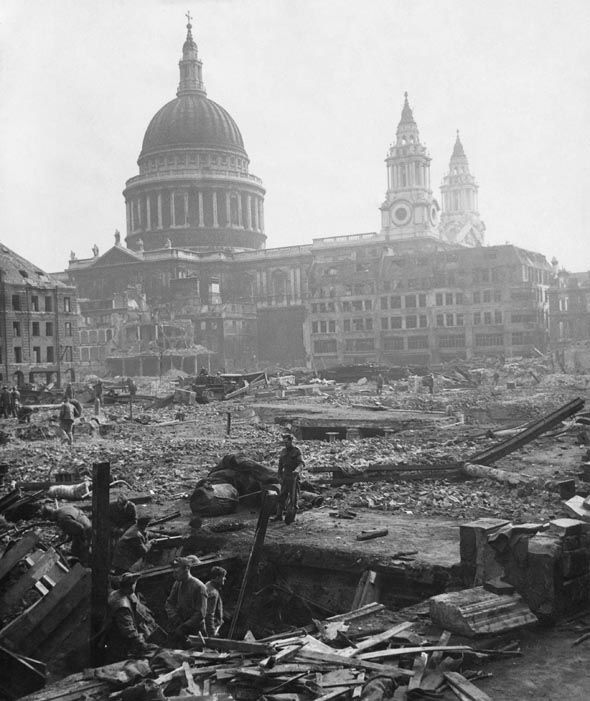 |
| St. Paul's Cathedral, London, taken 7 March 1941 (PA). |
March 1, 1941: Rettungsboje
March 2, 1941: Oath of Kufra
March 3, 1941: Germans in Bulgaria
March 4, 1941: Lofoten Islands Raid
March 5, 1941: Cooperation With Japan
March 6, 1941: Battle of Atlantic
March 7, 1941: Prien Goes Under
March 8, 1941: Cafe de Paris
March 9, 1941: Italian Spring Offensive
March 10, 1941: Humanitarian Aid
March 11, 1941: Lend Lease Become Law
March 12, 1941: A New Magna Carta
March 13, 1941: Clydeside Wrecked
March 14, 1941: Leeds Blitz
March 15, 1941: Cruisers Strike!
March 16, 1941: Kretschmer Attacks
March 17, 1941: Happy Time Ends
March 18, 1941: Woolton Pie
March 19, 1941: London Hit Hard
March 20, 1941: Romeo and Juliet
March 21, 1941: Plymouth Blitz
March 22, 1941: Grand Coulee Dam
March 23, 1941: Malta Under Siege
March 24, 1941: Afrika Korps Strikes!
March 25, 1941: Yugoslavia Joins The Party
March 26, 1941: Barchini Esplosivi
March 27, 1941: Belgrade Coup
March 28, 1941: Cape Matapan Battle
March 29, 1941: Lindbergh Rants
March 30, 1941: Commissar Order
March 31, 1941: Cookie Bombs
2020

